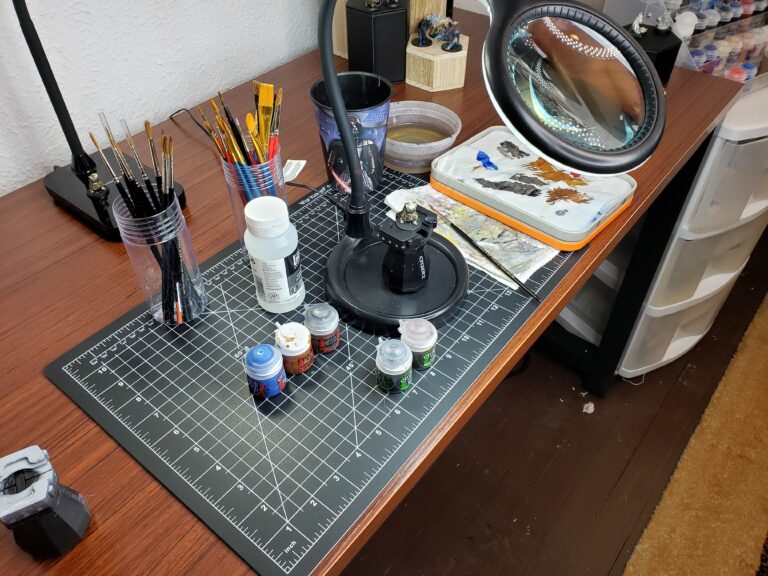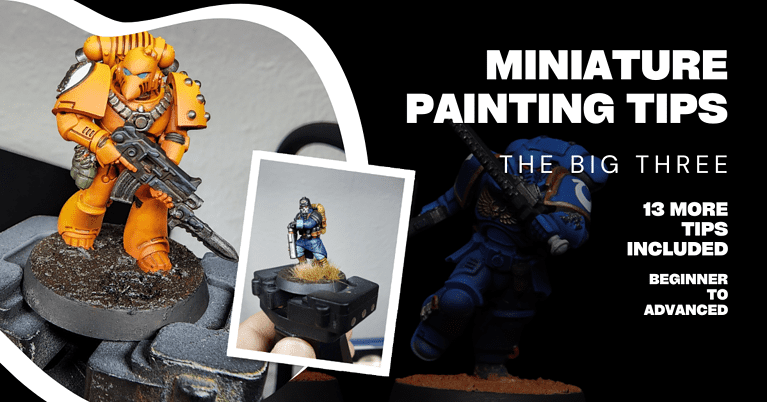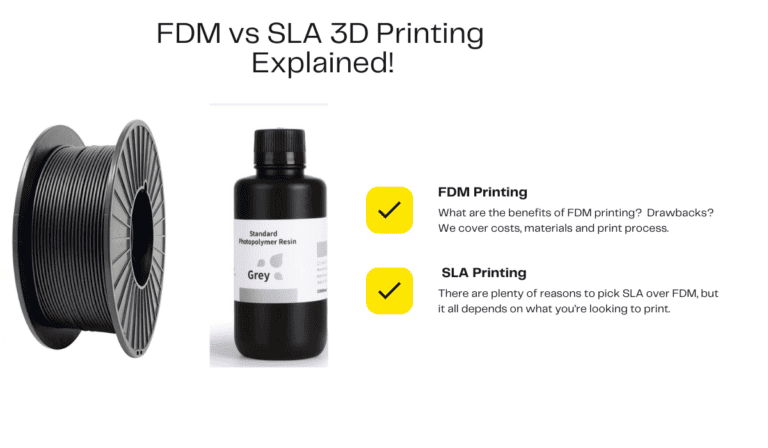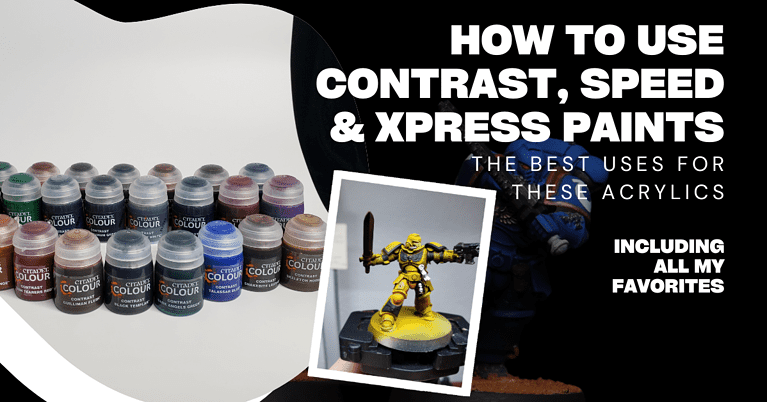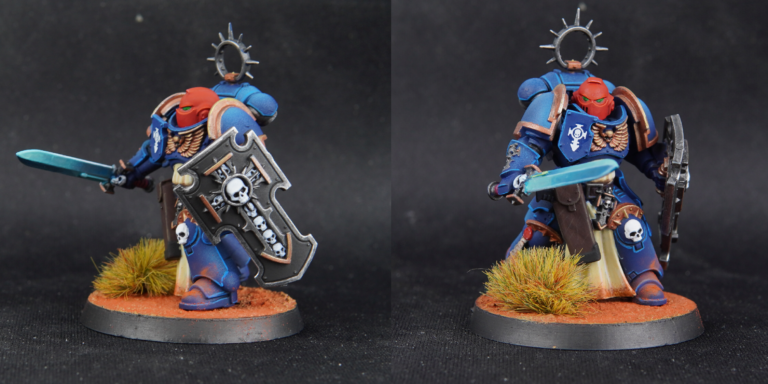How do Gravity Feed Airbrushes work? Dual Action Internal Mix
I’ve been miniature and model painting for years, and using an airbrush for nearly as long. In the miniature painting hobby we always use airbrushes that are Dual Action, Internal Mix, and Gravity feed.
I wanted to write an article on why we use this specific set of features. Part of that is understanding how they work. Don’t worry, it’s very simple. I’ll demystify it all for you so you can get started.
How does a Dual Action Gravity Feed Airbrush Work?
Paint is poured into the cup on top of the airbrush body. The airbrush is connected to an air source, typically an air compressor. When the trigger is pushed down, air flows through the airbrush. Pulling back on the trigger releases the paint, which flows down due to gravity. As air flows through, a low pressure area pulls the paint further down and into the air stream. When air and paint mix, the paint gets atomized into a spray pattern.
Gravity feed is a fairly straight forward design. The airbrush itself typically comes fully assembled and ready to use. A compressor might require a bit of set up, screwing on attachments like a pressure valve and connecting the air hose.
Once the compressor is set up you simply connect the airbrush via a hose. Paint is properly thinned and added to the cup. Its now ready to use.
Dual Action Gravity Feed airbrushes are perfect for hobbyists like miniature painters and artists. They have a great blend of control and simplicity. Other paint feed designs for airbrushes, like the siphon feed, are made to accommodate a lot of paint. For miniature and model painting that’s not necessary.
We prefer the versatility of being able to quickly and easily change airbrush paint colors, and add small amounts of paint via the gravity feed cup. The exposed paint cup also allows for adding new colors and mixing them in to existing colors on the fly.
Important Components of Dual Action, Gravity Feed Airbrushes
Trigger Assembly and Feel
Triggers in Dual Action Airbrushes are fairly straight forward in terms of what they do. Simply press down on them to start the air flow, and pull back to release the paint. All dual action airbrush triggers will act this way.
The differences though are in terms of quality and feel. Is the trigger smooth. Can you really feel the throttle in how much paint and air is flowing.
As you get better at airbrushing, you’ll want more and more control over exactly how much paint comes out and how much surface it covers. A high-quality trigger makes a difference in how precise you can be with the paint.
Conversely, if you’re simply priming or varnishing, the trigger is fairly irrelevant. Those tasks require much less precision, and are easy to do for a beginner. It’s more of a binary on/off spraying technique.
As an example, my Iwata airbrush has a smoother trigger than my Badger airbrush. This really only comes into play for fine detail work.
Nozzle Size
Nozzle size is a huge factor in airbrush performance. You always need to factor in the size you’re using. Smaller diameter will give a precise spray pattern and allow for finer detail. The down side of small nozzle size is they clog easily.
Larger nozzle size gives more paint and less clogging. You’re giving up ability to only hit very small areas though. At least, it’s more challenging with larger nozzle sizes.
Each has pros and cons to it which is why some people like to have different airbrush options available. Some also come with multiple needle and nozzle size attachments.
Needle:
Needles will regulate how much paint is let out of the airbrush cup. The needle is paired with the nozzle size. It moves back and forth as you rock the trigger back.
The more important factor with a needle is to make sure it’s clean and straight. Needles are easy to bend, and a bent needle will give an irregular spray pattern or cause paint to leak out before it should.
Pressure Regulator:
Typically the pressure regulator is on the air compressor. However if you don’t have one on the compressor, some airbrushes have a little knob on the airbrush itself.
The ability to regulate air pressure is very important in miniature painting. Most of your painting will be at the same air pressure, I typically keep mine at roughly 25-30 psi. When you need it to be lower or higher you want that capability.
Less air pressure is needed for very thin paint if you’re doing something like shading for example. Less pressure is usually the fix for something like spidering, which happens if the paint is coming out too quickly and is very thin. More pressure is good for larger surface coverage with thicker paint.
Paint Cup:
A gravity feed airbrush requires a paint cup on it. These are generally not complex. It’s simply a chamber to hold the paint. The only real consideration here is how much paint it can hold.
Anything around 1/3 of an ounce or so is more than enough for miniature and model painting. Any type of crafting, using airbrushes on cakes, and nails, and spray tanning, all requires less paint. The standard cup size is plenty big enough and easily refilled.
The cup does come with a lid but I never use mine. The last thing about a paint cup is it’s easy to clean. Some water and cleaner and it’s ready to swap colors.
Types of Airbrushes
I wanted to end this with a nice list for you to check out. I’ll keep things very straight forward so you can see the differences in airbrushes.
- Single Action Airbrush: In a single action airbrush, either pressing or pulling back on the trigger controls both air and paint flow simultaneously. Some airbrushes require push down, most require a pull back, but it’s either one or the other.
- Dual Action Airbrush: As we talked about, dual action or double action airbrushes offer more control as they allow the artist to control both the airflow and the paint flow independently. By pressing down the trigger, airflow starts, and pulling it back controls the paint flow.
- Gravity Feed: Again we covered this above, but gravity feed requires a paint cup or reservoir located above the nozzle. The paint is drawn down into the airflow as gravity pulls it down, allowing for efficient paint usage and easy color changes.
- Siphon Feed : This type of airbrush has a paint bottle or jar located beneath the airbrush. They use compressed air to create a vacuum, creating suction up from the jar and mixing it with the airflow. Siphon feed airbrushes are known for their large paint capacity but can be less efficient in terms of paint usage.
- Side Feed: A side feed airbrush has a paint cup or reservoir positioned on the side of the airbrush body. This design makes it very easy to access and see the paint level. I’ve never used one but I would guess it makes them suitable for artists who frequently need to change colors or work with small amounts of paint.
- Internal Mix Airbrush: Internal mix airbrushes have the paint and air mix inside the airbrush before being sprayed. This results in finer atomization and more control over paint application. Internal mix airbrushes are great for creating smooth gradients and precise details.
- External Mix Airbrush: External mix airbrushes mix the paint into the airflow outside the airbrush. The disadvantage is it results in a coarser spray pattern. They are often used for broader coverage and applying thicker materials like primers or varnishes.

